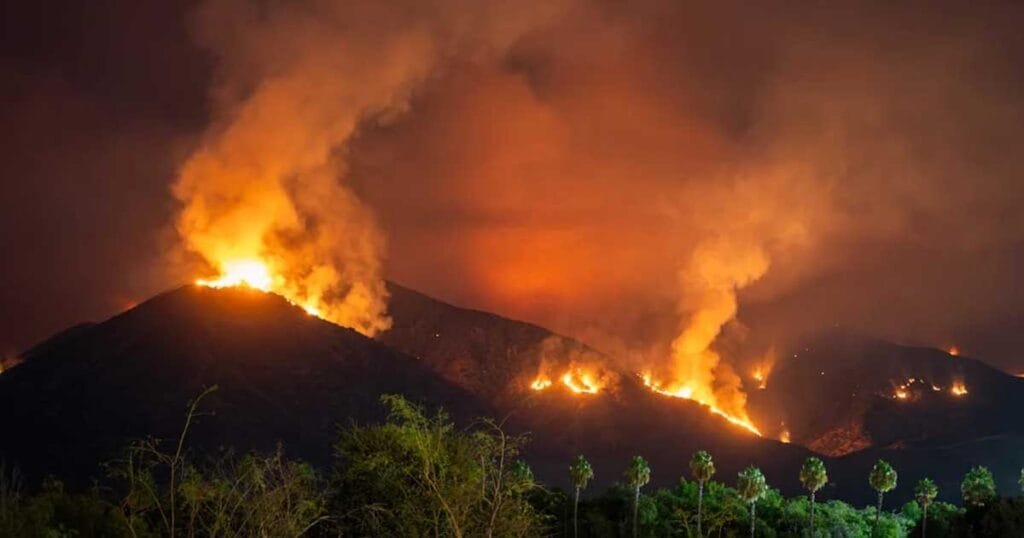- Over 150,000 evacuated, with 100,000 under warnings and overcrowded shelters.
- 16 dead, 18 missing, and 50+ hospitalized for burns and smoke inhalation.
- Rugged terrain and 50 mph winds complicate firefighting efforts.
- $20 billion in damages, with risks of landslides and ecological harm.
- State of emergency declared, federal aid requested amid criticism of fire prevention efforts.
California’s Palisades Fire has forced emergency officials to extend evacuation orders eastward into Santa Monica as flames continue to spread uncontrollably. By January 12, over 150,000 residents had been evacuated, while an additional 100,000 remain under evacuation warnings. Communities that once felt secure are now grappling with uncertainty and fear.
The evacuation centers established in Los Angeles and neighboring counties are overwhelmed, with reports of overcrowding leaving some evacuees without immediate shelter. Volunteers and local organizations are stepping in to provide resources, but the demand has surpassed available supplies.
The fire has claimed 16 lives, with 18 individuals still missing. Hospitals, already burdened by seasonal illnesses, are treating over 50 patients for burns and smoke inhalation. Local healthcare workers are urging residents to avoid exposure to smoke, as the air quality in affected areas has deteriorated to hazardous levels.
Sheriff Alex Villanueva has emphasized the importance of community cooperation: “Our primary focus is on saving lives. We are working tirelessly to ensure resources reach those in need during this crisis.”
Challenges in Firefighting
The Palisades Fire is presenting unprecedented challenges for firefighters. The rugged terrain of the Santa Monica Mountains has made it difficult to access fire lines, forcing crews to rely on aerial strategies. However, the persistent Santa Ana winds, gusting up to 50 mph, have scattered embers across vast distances, sparking new fires and complicating containment efforts.
“These conditions are unlike anything we’ve dealt with before,” said Fire Captain Sarah Wilson. “We are putting every resource into this battle, but the winds and dry vegetation are relentless adversaries.”
Firefighting efforts are further strained by the need to allocate resources to smaller fires igniting across Southern California. The red flag warning issued earlier this week remains in effect, with forecasts predicting stronger winds and no significant rainfall for the coming days.
Economic and Environmental Consequences
The Palisades Fire has already caused an estimated $20 billion in damages, making it one of the costliest fires in California’s history. Entire neighborhoods have been reduced to ash, and critical infrastructure, including power lines, water systems, and transportation networks has suffered extensive damage.
Beyond the immediate economic toll, the environmental impact is equally concerning. The destruction of native vegetation has heightened the risk of soil erosion and landslides, especially in the steep terrains of the Santa Monica Mountains. Environmental scientists warn that these landslides could devastate communities already vulnerable from fire damage.
The fires have also released significant amounts of carbon dioxide into the atmosphere, exacerbating global warming. Experts stress that addressing these environmental issues is critical for preventing long-term ecological degradation in the region.
Government Response
Governor Gavin Newsom has declared a state of emergency and called for federal aid, including additional firefighting resources and financial assistance.
The California National Guard has been deployed to support evacuation efforts, enforce road closures, and provide logistical support to firefighting teams.
Despite the swift government response, criticism has emerged over inadequate forest management and reduced budgets for fire prevention programs. Experts argue that urban planning reforms and investments in sustainable fire management practices are necessary to mitigate future crises.
Local and federal agencies are coordinating to ensure that displaced residents receive housing, medical care, and other critical support. Officials are urging residents to remain vigilant, stay informed through official updates, and adhere to evacuation orders when issued.
Looking Ahead
The Palisades Fire serves as a stark reminder of California’s growing vulnerability to wildfires, driven by climate change, urban expansion, and insufficient fire prevention measures. As containment remains elusive, authorities are emphasizing the need for systemic reforms in climate adaptation and disaster preparedness.
Residents are encouraged to prepare emergency kits, develop evacuation plans, and remain connected to reliable sources of information. With fire seasons now a year-round phenomenon, California must adapt to an evolving landscape of environmental challenges.


